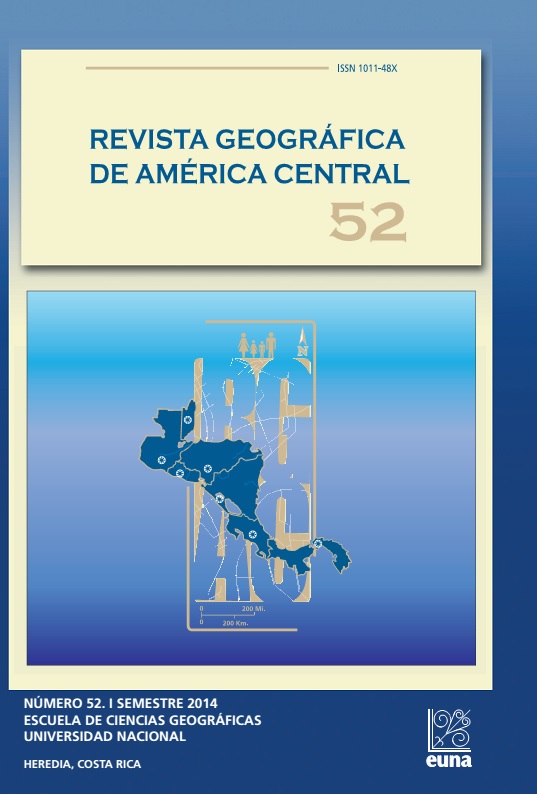MANGROVE FOREST FRAGMENTATION BECAUSE OF SUN AND BEACH TOURIST DEVELOPMENT IN THE NORTHERN PACIFIC OF COSTA RICA: A CASE STUDY
Keywords:
Mangrove Nandamojo, tourism, landscape, ecosystem fragmentation, colonial discourseAbstract
Tourism along the Pacific coast of Costa Rica has led to significant changes in mangrove ecosystems. There has been a substitution of this forest type for another more adapted to widespread tourist concepts, such as the existence of palm trees. These substitution processes involve the movement of species, mangrove removal and habitat reduction for different flora and fauna species. This is due mainly to economic criteria, where spaces in the tourist imaginary are attempted to be recreated, thereby scarifying the original natural heritage landscape and replacing it with scenery more customary to international standards of sun and beach tourism. This article aims to raise awareness of the changes and to show that the original mangrove ecosystems envelope unmeasured richness that have not yet been calculated in biodiversity terms.References
Ballestero, D. (2011). Memoria Jornadas Académicas 2011. Universidad
Nacional. Condiciones oceanográficas y cambio del nivel del mar en playa Junquillal, pacífico Norte de Costa Rica (págs. 55-56). Heredia: UNA-CR.
Bravo, J. & Windevoxhel, N. (1997). Manual para la identificación y clasificación de humedales en Costa Rica. San José, Costa Rica: UICNORMA/MINAE/Embajada de los Países Bajos.
Cabrera, J. (2008). Patrimonio natural del estado y zona marítimo terrestre. Ambientico, 10-12.
Cordero, A. (2002). ¿Turismo Sostenible en Costa Rica? Caso de QueposManuel Antonio. En D. y. Hiernaux, Imaginarios sociales y turismo sostenible, 37-125. San José, C.R.: FLACSO.
Cruz, R. (2011). Los manglares de Costa Rica. Humedales, Biodiversidad y Gente. Nicoya, Costa Rica: CEMEDE-UNA.
Espinoza, N. (13 de Abril de 2012). Aspectos generales del Refugio Camaronal.(J. Picón, Entrevistador)
Gutrie, V. (15 de 09 de 2012). Proyecto de conservación de tortugas marinas. (J. Picón, Entrevistador)
Hiernaux, N. (2002). Turismo e imaginarios. En N. Hiernaux, A. Cordero,& L. Van Duinen, Imaginarios sociales y turismo sostenible, 531. San José, Costa Rica: FLACSO-Costa Rica.
Larrosa, J. & Martinez, C. (2008). El palmeral de Elche. Patrimonio, identidad local e imagen turística. en J. A. Baidal, Espacios turísticos: mercantilización, paisaje e identidad. España: Editorial Aguaclara, S.L.
Montoya, F. (2009). Historias de Junquillal. A la memoria de Don Anacleto Rodríguez 1911-2009. San José, Costa Rica: Poliart Impresores S.A.
Pizarro, F., Bravo, J., Piedra, L., Asch, J. & Asch, C. (2004). Manual de
procedimeintos para el manejo de los manglares de Costa Rica. Heredia, Costa Rica: EUNA.
Redondo, A.. (2008). Desarrollo turístico descontrolado. Ambientico, 181, 7-10.
Santos, X. (2008). Paisaje e identidad en la promoción de la imagen de los destinos turísticos. En J. A. Baidal, Espacios turísticos: mercantilización, paisaje e identidad, 195-207. España: editorial Aguaclara, SL.
Schüttler, E., & Karez, C. (2008). Especies exóticas invasoras en las reservas de biósfera de América Latina y el Caribe. Montevideo: UNESCO.
Zamora, P., & Cortés, J. (2009). Los manglares de Costa Rica: el Pacífico norte. Revista de Biología Tropical, 57(3), 473-488.
Downloads
How to Cite
Issue
Section
License
Proposed policy for journals offering Open Access
Authors publishing their works in the Journal acknowledge and agree to the following terms:
a) Authors retain the copyrights to their works and guarantee the Journal the right to be the first to publish their works, under the Creative Commons License Attribution-NonCommercial-ShareAlike 4.0 International, CC BY-NC-SA 4.0 International (https://creativecommons.org/licenses/by-nc-sa/4.0/deed.es), which allows others to share works upon complying with the acknowledgment of authorship and mention of the Journal as the original publisher of the work.
b) Authors are permitted to separately establish additional agreements for the non-exclusive distribution of the official edition of the work published in the Journal (for example, authors may desire to place the work in an institutional repository or incorporate it into a book that is to published elsewhere) so long they acknowledgment to recognize the Journal as the original publisher. The aforementioned additional agreements must respect the terms of the non-profit character and sharing philosophy of the original license (CC BY-NC-SA 4.0 International, https://creativecommons.org/licenses/by-nc-sa/4.0/deed.es).
c) Authors are encouraged to archive the post-print or editor/PDF version in Open Access repositories.






 REVGEO is licensed under https://creativecommons.org/licenses/by-nc-sa/4.0/deed.es
REVGEO is licensed under https://creativecommons.org/licenses/by-nc-sa/4.0/deed.es
.svg_4.png)

_(1).png)
_(1)_(1)_(1)_1.png)
(2)(1)(1)(1).png)
